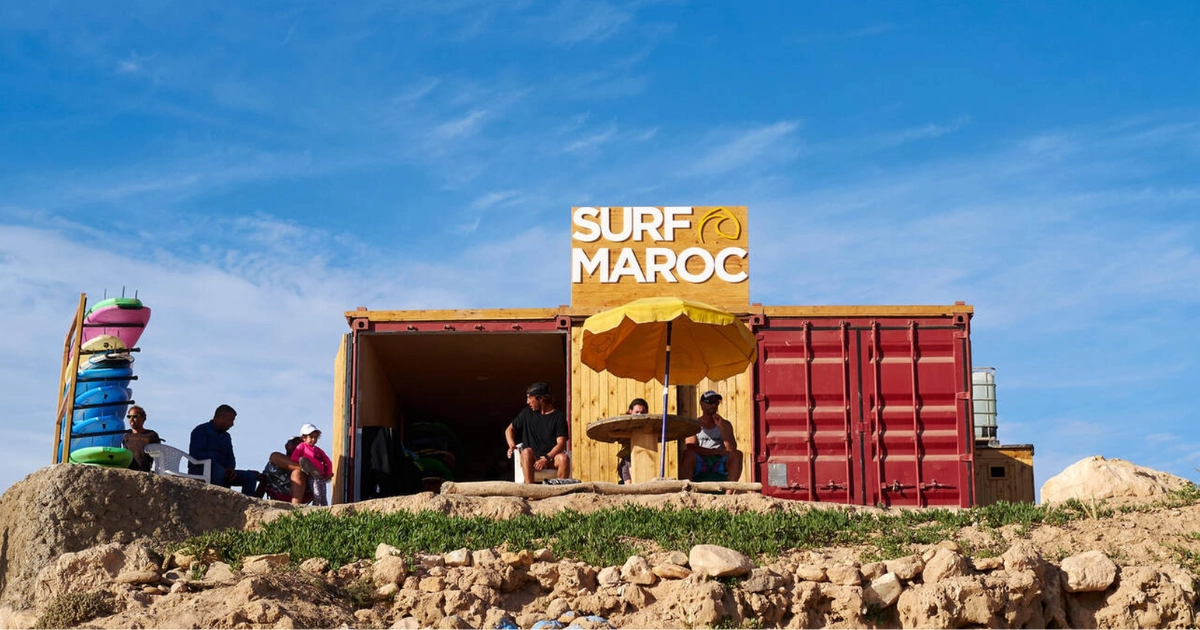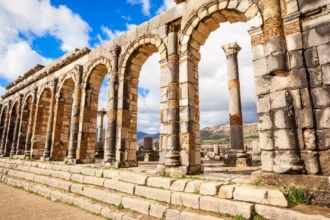Nestled along Morocco’s sun-kissed Atlantic coast, this laid-back village blends golden beaches with authentic cultural charm. Known for its year-round warm weather and welcoming locals, it’s a magnet for travelers seeking both relaxation and adventure. Just a short drive from Taghazout, the area thrives as a surf haven with waves suited for all skill levels.
You’ll find a slower pace here compared to busier Moroccan cities. Think mint tea shared with new friends, vibrant markets selling handmade crafts, and evenings filled with the aroma of tagine. The village’s location makes it a perfect base to explore nearby bays, cliffs, and fishing ports along the coast.
Planning your trip? Prioritize learning basic transportation options—shared taxis and buses connect key spots affordably. Pack light layers for sunny days and cooler nights. Whether you’re chasing consistent surf breaks or eager to dive into local traditions, this coastal hub delivers an unfiltered slice of Moroccan life.
Key Takeaways
- Ideal for surfers year-round, with waves catering to beginners and experts
- Mild winters and warm summers make any season a good time to visit
- Easy access to Taghazout and other Atlantic coast attractions
- Affordable local transport options like shared taxis simplify exploration
- Immerse in culture through markets, cuisine, and community interactions
Introduction to Tamraght and Its Allure
Where North African traditions meet surf culture, this coastal village offers a rare mix of authenticity and adventure. Whitewashed buildings with terracotta roofs line winding streets, while the Atlantic’s roar reminds visitors why they came. Locals greet you with steaming mint tea, their hospitality as warm as the year-round sunshine.
A Living Postcard of Moroccan Life
Donkeys carry fresh bread past surf shops, blending old and new. Weekly markets burst with handwoven rugs and spices piled like rainbows. One resident shares:
“Our village thrives when visitors embrace both surfboards and tea cups.”
– Mohamed, Café Owner
Secrets of the Surf Coast
Just 30 minutes from Agadir Airport, the area hides world-class breaks. Banana Point delivers peeling right-handers, while nearby bays offer gentler waves for learners. Check how key spots compare:
| Surf Spot | Wave Type | Skill Level | Best Season |
|---|---|---|---|
| Banana Point | Right reef break | Intermediate+ | Winter |
| Devil’s Rock | Beach break | Beginner | Summer |
| Anchor Point | Long right | Advanced | Fall |
Morning sessions here often turn into afternoons exploring cliffside trails. Many travelers extend their stays once they realize how many days of discovery the coast offers. As one regular put it: “The waves brought me, but the soul kept me coming back.”
Getting to Tamraght: Routes and Transportation
Reaching this Moroccan surf hub is simpler than you might think. With Agadir’s Al Massira Airport just 30 minutes away, you’ll transition from plane to paradise faster than a beginner catches their first whitewash. Let’s break down your options for smooth arrivals.
Airport Transfers Made Simple
Grand taxis (shared 4x4s) wait outside baggage claim. Split the ride with other travelers to cut costs—expect to pay around $10 per person. Prefer independence? Private transfers take you door-to-door in 40 minutes. Early birds catch both waves and buses: public transit runs hourly until sunset for under $2 a ticket.
Coastal Connections
Already in Morocco? CTM buses from Marrakech or Essaouira stop in Agadir. From there:
| Option | Time | Cost | Best For |
|---|---|---|---|
| Local taxi | 25 mins | $15-20 | Groups |
| Bus #60 | 40 mins | $1 | Solo travelers |
| Boardwalk | 2.5 hrs | Free | Scenic strolls |
A local driver advises:
“Morning buses fill fast with surfboards—arrive early to claim your spot.”
– Hassan, Taxi Driver
Day-trippers love the coastal walk from Taghazout. Pack water and sunscreen—you’ll pass hidden beaches perfect for quick dips. Need to maximize ocean time? Private drivers know backroad shortcuts to popular breaks.
When Is the Best Time to Visit Tamraght?
Timing your coastal escape requires balancing wave quality with cultural rhythms. The village thrives year-round, but your ideal time depends on whether you’re chasing barrels or laid-back beach days. Let’s break down how seasons shape both surf and local life.
Surfing Conditions, Waves, and Weather Patterns
Winter (November-February) brings powerful northwest swells—perfect for experienced surfers. Waves at breaks like Devil’s Rock reach 8-10 feet, with water temps around 64°F. Summer (June-August) offers smaller, friendlier waves for learners, plus warmer 72°F waters.
| Season | Wave Height | Water Temp | Crowd Level |
|---|---|---|---|
| Winter | 6-10 ft | 64°F | Moderate |
| Summer | 2-4 ft | 72°F | Busy |
Spring and fall deliver shoulder-season perks. March-May sees fewer crowds at beachfront cafés serving fresh seafood tagine. September-October combines warm waters with rising swells—a sweet spot for intermediate riders.
Seasonal Highlights for Beginners and Advanced Surfers
New to surfing? Target June-August for:
- Calmer waves at learner-friendly bays
- Sunny days ideal for post-surf beach naps
- Night markets grilling sardines and spiced kefta
Seasoned riders should prioritize winter. As local instructor Amina notes: “December’s offshore winds create glassy conditions you won’t find in summer.” Pair dawn patrols with evenings sampling harira soup at family-run eateries.
For a balanced time, visit April-May. You’ll avoid peak tourist times while enjoying warm days and lively village festivals. Bonus: sunset beach bonfires with locals become weekly traditions.
Essential Visa, Currency, and Language Information
Navigating travel essentials ensures your Moroccan adventure starts smoothly. Understanding entry rules, local costs, and communication basics helps you focus on soaking up the vibe instead of paperwork. Let’s break down what you need to know before arrival.
Visa Requirements and Entry Tips for American Travelers
U.S. passport holders enjoy visa-free stays for up to 90 days. Ensure your passport has six months’ validity beyond your travel dates. A customs officer shares:
“Always carry your accommodation details—officials might ask for proof of where you’re staying.”
– Agadir Airport Customs
Beginners should note: credit cards work in cities, but rural areas often require cash. Keep small bills for markets and taxis.
Understanding the Moroccan Dirham and Language Basics
The Moroccan Dirham (MAD) is closed-currency, meaning you’ll exchange money upon arrival. Compare options:
| Method | Exchange Rate | Convenience | Best For |
|---|---|---|---|
| Airport kiosks | Fair | High | Quick access |
| ATMs | Best | Medium | Better prices |
| Local banks | Good | Low | Large sums |
Most locals speak Arabic or French. Learn these phrases to connect:
- “Shukran” (Thank you)
- “Bslama” (Goodbye)
- “Shhal hada?” (How much is this?)
English works in tourist areas, but using basic Arabic shows respect. This effort elevates your vibe from visitor to welcomed guest.
tamraght Surf Spots and Beach Adventures
The Atlantic coast near this Moroccan village pulses with surf breaks that draw wave riders from every corner of the globe. Whether you’re paddling out at dawn or exploring hidden coves, the region delivers unforgettable ocean experiences. Let local experts guide you to the best waves and safest practices.
Where to Catch Your Perfect Wave
Banana Point stands out as the crown jewel for intermediate surfers. Its peeling right-handers work best during winter swells. Nearby Devil’s Rock offers gentler beach breaks ideal for first-timers. Compare top spots:
| Break | Wave Type | Skill Level | Local Tip |
|---|---|---|---|
| Banana Point | Right reef | Intermediate+ | Rent a thicker wetsuit |
| Devil’s Rock | Beach break | Beginner | Go at high tide |
| Mystery Left | A-frame peaks | Advanced | Watch for rocks |
A surf instructor shares: “The front side of Banana Point gets crowded—walk 10 minutes north for quieter peaks.”
Staying Safe in the Swell
Respect the ocean’s power. Check daily surf reports and ask guides about currents. Avoid drinking tap water—stick to bottled or filtered options. Key tips:
- Rip currents are common: swim parallel to shore if caught
- Apply reef-safe sunscreen to protect marine life
- Hydrate with sealed water bottles after sessions
Every person exploring these beaches should learn basic Arabic phrases. Simple greetings like “Salam alaykum” (Peace be with you) deepen connections with the local culture. Pack a reusable water bottle—many cafés offer free refills to reduce plastic waste.
Local Culture, Dining, and Relaxation Spots
Savor the rhythm of coastal Morocco through its flavors and traditions. Between surf sessions, the village reveals its soul in steaming tagines, bustling markets, and sunlit terraces where time slows to a crawl.
Exploring Authentic Moroccan Cuisine and Cafés
Family-run eateries serve quality dishes crafted from generations-old recipes. Try rfissa (shredded pancake stew) at cliffside cafés or fresh-caught sardines grilled over olive wood. One chef explains:
“Our food tells stories—every spice blend remembers the hands that mixed it.”
– Fatima, Dar Tajine
Don’t miss mint tea rituals. Locals pour it from heights to aerate the sweetness, a practice perfected over years. For coffee lovers, drive 10 minutes to Agadir’s artisanal roasteries. Their organic blends pair perfectly with almond-stuffed pastries.
Experiencing the Local Vibe and Traditional Markets
Sunday markets burst with color—think hand-dyed wool, argan oil soaps, and pyramids of saffron. Compare key shopping spots:
| Market | Specialty | Best Time |
|---|---|---|
| Souk El Had | Spices & ceramics | Morning |
| Taghazout Bazaar | Surfwear & crafts | Afternoon |
| Night Market | Street food | Sunset |
Summer eveniFngs hum with beach bonfires and live gnawa music. Many camp hosts organize cultural exchanges—learn Berber drumming or henna art. As the stars emerge, join locals sharing stories over shared platters of couscous. This coastal gem proves that relaxation isn’t a season—it’s a way of life, refined over countless years.
Accommodation and Stay Options in Tamraght
Your coastal escape deserves a home base that matches your travel style. From surf-shack-chic to luxury retreats, this stretch of Morocco’s Atlantic coast serves up stays for every budget and season.
Budget-Friendly Apartments, Surf Camps, and Boutique Riads
Surf camps along the main road offer dorm beds from $15/night, including board rentals and daily yoga. Many host family-style dinners where travelers swap wave stories. For more privacy, private apartments with kitchenettes start at $40/night—ideal for longer stays.
| Option | Price Range | Perks | Best Time to Visit |
|---|---|---|---|
| Surf Camp | $15-30 | Group lessons included | Summer |
| Boutique Riad | $60-90 | Private terraces | Spring/Fall |
| Self-Catering Apartment | $40-70 | Full kitchens | Winter |
A surf camp owner shares:
“Our weekly packages include transport to Taghazout’s breaks—you’ll ride waves with new friends by day and starfish on rooftop loungers by night.”
– Youssef, Wave House Camp
Luxury Resorts and the Best Beachfront Experiences
Five-star resorts dot the coastline between Tamraght and Taghazout. Expect infinity pools overlooking surf breaks and spa treatments using argan oil. For the ultimate splurge, book a cliffside villa with private beach access during peak season (December-March).
Pro tip: Properties near the main road provide easy access to both villages. Early bookings secure the best time deals—especially for ocean-view suites. Many luxury stays include sunset dhow cruises or guided hikes to hidden coves.
Getting Around: Local Transportation and Connectivity
Navigating Tamraght’s laid-back streets requires smart planning for connectivity and transport. You’ll find reliable options to get Tamraght essentials sorted quickly—from staying online to moving between coastal gems.
SIM Cards, Private Taxis, and ATMs in the Village
Local shops sell prepaid SIM cards from Maroc Telecom and Orange. A shop owner advises:
“Buy the 10GB plan—it covers remote spots like Paradise Valley and saves you from hunting Wi-Fi.”
– Karim, Mobile Shop
Compare transport choices:
| Option | Cost per person | Best For |
|---|---|---|
| Shared taxi | $2-4 | Short village trips |
| Private taxi | $10-15 | Airport transfers |
| Bus to Agadir | $1 | Budget explorers |
ATMs near the main square dispense dirhams. Use them before day trips to Paradise Valley—cash rules in rural areas. One traveler notes: “I withdrew extra for argan oil purchases at roadside spots like Aït Melloul.”
Always confirm travel insurance covers surf injuries and lost boards. Shared rides cost less per person, but private taxis offer flexibility for dawn patrols. Pro tip: Book return trips to get Tamraght transport locked in early during peak season.
Conclusion
Your journey to Morocco’s surf coast becomes unforgettable when armed with local insights. Local guides unlock hidden beach trails and cultural gems you’d miss alone. Their expertise transforms surf sessions into full-immersion experiences.
Fuel adventures at family-run cafes restaurants serving harira soup and msemen flatbread. Need to buy alcohol? Licensed hotels and Agadir’s Carrefour Market stock select beverages—plan purchases around limited availability.
Arrange private taxis through reputable drivers for stress-free airport transfers or sunset cliff drives. For shorter trips, shared rides save dirhams but lack flexibility. Stay connected with a Maroc Telecom SIM card—10GB plans cover remote areas better than roaming.
From catching waves to navigating markets, this guide prepares you for coastal Morocco’s rhythms. Pack curiosity, respect local customs, and let the Atlantic breeze guide your discoveries. Your authentic Moroccan escape starts here.
FAQ
How do I get from Agadir Airport to Tamraght?
The easiest way is via private taxi (45-minute drive). Shared buses or CTM coaches offer budget options but require transfers. Pre-book airport transfers through accommodations for convenience.
When is the best time to surf in Tamraght?
October to April brings consistent waves for advanced surfers. Beginners prefer May–September for smaller swells. Check Surfline or local guides for real-time updates.
Are visas required for U.S. citizens visiting Morocco?
No visa is needed for stays under 90 days. Ensure your passport is valid for six months beyond your arrival date. Carry proof of onward travel if asked.
Which surf spots are ideal for beginners?
A: Banana Point offers gentle, rolling waves. Nearby Devil’s Rock and Taghazout Bay are also beginner-friendly. Local surf schools provide gear and lessons daily.
Can I use credit cards in Tamraght?
Cash (Moroccan dirham) is preferred. ATMs are available near the main road. Larger surf camps and upscale restaurants may accept cards, but carry cash for markets and taxis.
Where can I find authentic Moroccan food?
Try family-run cafés along the main road for tagine or couscous. Fresh seafood is served at beachfront spots. Visit the Aourir market (5km away) for local produce.
What’s the vibe like in Tamraght?
Expect a relaxed, surf-centric atmosphere. The village blends traditional Berber culture with a global traveler community. Evenings are quiet, with bonfires and acoustic music at surf camps.
Are there luxury accommodations nearby?
Yes. Upscale beachfront riads and resorts like Tamraght Surf Palace offer pools and ocean views. Taghazout Bay has premium stays a short drive away.
Is tap water safe to drink?
Stick to bottled water. Many guesthouses provide filtered water stations. Avoid ice in drinks at smaller cafés unless confirmed purified.
How do I stay connected?
Purchase a SIM card from Maroc Telecom or Orange at Agadir Airport. Wi-Fi is available at most surf camps, but speeds vary. Signal strength is reliable in central areas.





